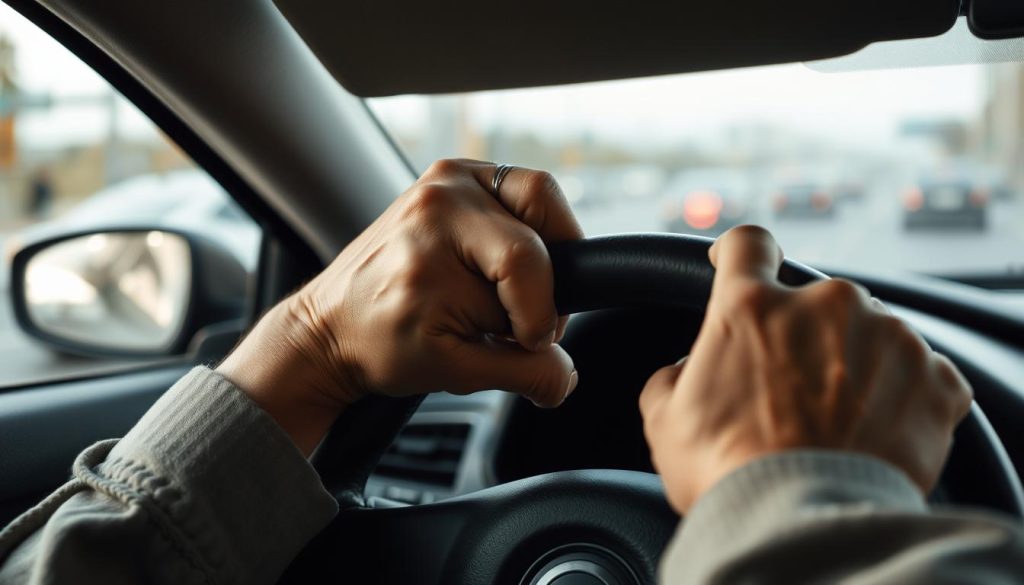anxietywhendriving.com highly recommends The Driving Fear Program to overcome your Driving Anxiety 90 Days Money Back Guarantee!
-->Click Here<--

Did you know that up to 12% of adults in the U.S. struggle with a fear of driving, known as “vehophobia”? This fear can really limit your life, stopping you from enjoying the freedom of driving. But, the good news is, you can beat this fear.
Growing up, I saw my mom’s fear of driving, which made me anxious too. Hearing about car accidents made me even more scared. Bad experiences, like getting a flat tire, made my fear worse. For years, I couldn’t look forward to going out and felt stuck, needing others to drive for me.
I decided to face this fear and found many ways to overcome it. Learning defensive driving skills and calming strategies helped me. I learned that I could feel confident and in control while driving.
Key Takeaways
- Driving phobia is a common condition that affects up to 12% of adults in the U.S.
- Negative experiences and witnessing others’ driving fears can contribute to developing a fear of driving.
- Overcoming driving anxiety is possible through techniques like defensive driving, calming strategies, and seeking professional help.
- Regaining confidence and independence behind the wheel can significantly improve one’s quality of life.
- Developing mindful driving practices and setting achievable goals can help conquer the fear of driving.
Understanding Driving Phobia (Vehophobia)
Driving phobia, also known as vehophobia, is a specific anxiety disorder. It makes people intensely afraid of driving. This fear can really limit their daily life and freedom.
It’s hard for them to do simple things like go to work or run errands because of this fear.
What is Driving Phobia?
Vehophobia is a type of specific phobias. These are anxiety disorders that cause irrational fears of certain objects or situations. For driving phobia, the fear of driving is overwhelming.
Symptoms of Driving Phobia
The symptoms of driving phobia can be very intense and scary. People with this condition might feel:
- Sweating
- Trembling
- Rapid breathing
- Chest pain
- Nausea
These physical signs often come with anxious thoughts. They might worry about losing control, causing an accident, or having a panic attack while driving. These thoughts and feelings make it hard for them to feel safe or confident on the road.
“Driving phobia is a common condition that can have a significant impact on an individual’s quality of life. Understanding the symptoms and seeking professional help is the first step towards overcoming this fear and regaining the freedom to drive.”
Causes of Driving Phobia
Driving phobia, also known as vehophobia, has many causes. Knowing what causes it is key to beating the fear of driving.
Driving and PTSD
PTSD from a scary driving event, like a car crash, can lead to driving phobia. This trauma causes flashbacks and anxiety while driving. It makes people feel unsafe and out of control.
Fear of Driving and OCD
OCD can also make people afraid to drive. Those with OCD might worry about hitting someone or causing an accident. They might check the rearview mirror a lot or avoid driving to feel safe.
These fears can make driving very hard. It can stop people from being independent and doing daily tasks that need driving.
| Causes of Driving Phobia | Description |
|---|---|
| PTSD | Trauma from a past driving-related incident, such as a car accident or witnessing a collision |
| OCD | Intrusive thoughts about causing an accident and compulsive behaviors to prevent it |
| Panic Attacks | Experiencing intense fear and physical symptoms while driving |
| Driving Conditions | Anxiety about navigating highways, bridges, or tunnels |
Understanding the causes of driving phobia, including PTSD and driving fear, as well as OCD and fear of driving, is the first step in developing effective strategies to overcome this debilitating condition.
Overcoming Specific Driving Fears
Driving on freeways, highways, bridges, and tunnels can be scary for many. But, there are ways to face these fears and feel more confident while driving.
Conquering the Fear of Highways and Freeways
Merging onto fast highways or freeways is a big fear for many. Exposure therapy is a great way to tackle this fear. It helps you face your fear little by little, building your confidence.
Facing the Fear of Bridges and Tunnels
Driving over bridges or through tunnels can make people very anxious. Cognitive-behavioral therapy (CBT) is very helpful for this fear. It helps you change your thoughts and find ways to deal with your anxiety.
Therapists might also use virtual reality to help with exposure therapy. This lets you face your fears in a safe, controlled way before you try it in real life.
| Driving Scenario | Recommended Strategy |
|---|---|
| Freeways and Highways | Exposure Therapy |
| Bridges and Tunnels | Cognitive-Behavioral Therapy (CBT) |
Using these proven methods, people can learn to manage their driving fears. This way, they can enjoy driving on freeways, highways, bridges, and tunnels again.

Treatment for Driving Anxiety
It’s possible to beat the fear of driving with the right treatment for driving anxiety. Cognitive-behavioral therapy (CBT), especially exposure therapy, is very effective. This method helps people face their driving fears by slowly exposing them to the things they fear.
Therapists work with clients to create a special plan for exposure. This might start with driving in virtual reality and then move to real driving. Virtual reality is a good first step, but facing real situations is key to overcoming anxiety.
CBT is not the only tool for therapy for driving phobia. Other methods include relaxation techniques, visualization, and learning ways to handle anxiety when driving gets tough. The goal is to face fears slowly and with support.
“Confronting your fears, rather than avoiding them, is the most effective way to overcome driving phobia. With the right support and evidence-based strategies, individuals can regain their confidence and reclaim the joy of driving.”
Combining CBT, exposure exercises, and other coping strategies can help beat driving anxiety. It’s a tough journey, but the benefits of overcoming driving fears are huge.
Dealing with Panic Attacks While Driving
Having a panic attack while driving can be scary and disrupt your journey. But, it’s important to know these intense feelings are not dangerous. By using the right strategies, you can get through a panic attack and keep driving safely.
The first thing to do is to know what’s happening and accept it. This awareness helps you take charge and use methods to fight the panic. One great way is to practice paced breathing. Taking slow, deep breaths can slow down your heart and calm your mind, helping you feel more in control.
If the panic attack gets too much, pull over and find a safe place to wait. Here, you can use relaxation techniques like progressive muscle relaxation or visualization exercises until it passes. Remember, the panic will end, and with practice, you can handle these moments better.
It’s key to have a set of coping techniques for driving anxiety if you have panic attacks while driving. By learning to manage panic attacks and driving phobia, you can feel more confident and free on the road.
“The secret of getting ahead is getting started. The secret of getting started is breaking your complex overwhelming tasks into small manageable tasks, and then starting on the first one.” – Mark Twain
| Coping Techniques for Driving Anxiety | Benefits |
|---|---|
| Paced Breathing | Regulates heart rate and calms the mind |
| Progressive Muscle Relaxation | Reduces physical tension and promotes relaxation |
| Visualization Exercises | Helps shift focus and manage anxiety |
My Personal Journey
For years, I was trapped by a fear of driving. It kept me from enjoying life’s adventures. The mere thought of driving made me anxious, imagining all the bad things that could happen.
But one day, I decided I’d had enough. I couldn’t let this fear control my life anymore.
The Tipping Point: One Day, I Decided to Drive
I decided to face my fear head-on. I started by driving with a friend, making it easier for me. As I got more comfortable, I began to drive further and on more challenging routes.
Soon, I was driving from Boston to New York City. This was a huge step for me. It made me feel proud and more determined to keep pushing my limits.
Document your Progress and Celebrate Milestones
I kept a journal to track my progress. I wrote about my feelings and the challenges I faced. Seeing my growth in writing helped me stay motivated and confident.
By confronting my driving anxiety step by step, I gained my freedom. My journey shows that with determination and facing your fears, you can overcome any challenge.
Tips to Overcome Fear of Driving
Overcoming the fear of driving is tough, but doable with the right approach. Whether you’re new to driving or have been scared for years, these tips can help. They’ll help you regain control and beat your driving fear.
List the Benefits of Being Able to Drive
Thinking about the good things about driving can motivate you. Make a list of the perks, like quicker trips, carrying more stuff, and feeling safer and more independent. Remember these benefits when you start to feel nervous driving.
List Your Specific Fears & Re-frame Your Thoughts
Identify what scares you about driving, like merging or parallel parking. Then, change those scary thoughts into positive ones. Remember, most drivers are careful, and making mistakes is part of learning.
Find Ways to Relax
Adding relaxation techniques to your driving can ease anxiety. Try deep breathing, listen to calming music, or use visualization before and during drives. Find what relaxes you the most.
Set Goals & Take One Step at a Time
Building your confidence in driving is important. Set goals like driving for a certain time or distance. Celebrate your successes. Don’t stress too much about being perfect; just focus on small steps and celebrate each one.
By using these tips, you can enjoy the benefits of driving and overcome your driving fear. It takes patience, determination, and a positive attitude.
How Not to be Afraid of Driving
Overcoming driving fear is tough, but doable with the right approach. It’s about facing your fears, using proven methods, and being patient. These steps help you conquer driving fear.
Start small to build confidence. Practice in safe places like empty lots or quiet streets. Then, move to busier areas. Strategies to conquer driving fear include exposure therapy and cognitive-behavioral therapy. These help you face your fears and change negative thoughts.
It’s key to celebrate your small wins. Every time you face a tough drive, celebrate. This builds your confidence. Remember, it’s a journey of patience and kindness to yourself.
Keep practicing, change your thoughts, and celebrate your wins. This builds your driving skills and confidence. The freedom of driving is worth the effort.
“The greatest weapon against stress is our ability to choose one thought over another.” – William James
| Strategies to Conquer Driving Fear | Benefits of Being Able to Drive |
|---|---|
| Exposure Therapy Cognitive-Behavioral Therapy Gradual Practice in Low-Stress Environments Relaxation Techniques Visualization Exercises | Increased Independence and Freedom Improved Access to Job Opportunities Easier Transportation for Daily Activities Enhanced Sense of Accomplishment Reduced Reliance on Others for Rides |
Driving Anxiety is Common
Driving phobia, or the intense fear of driving, is quite common. It’s estimated that 8-12% of adults in the United States face driving anxiety each year. This fear can stem from past traumatic experiences or underlying mental health issues like PTSD or OCD.
What Causes Fear of Driving?
Some common reasons for driving phobia include:
- Past traumatic experiences, such as being in or seeing a car accident
- Panic attacks or feeling like you’re losing control while driving
- Underlying mental health conditions like PTSD or OCD
- Lack of confidence or experience behind the wheel
- Anxiety about causing harm to oneself or others while driving
Symptoms of Driving Phobia
People with a fear of driving often show physical and psychological symptoms, such as:
- Physical symptoms: Sweating, trembling, rapid heartbeat, and muscle tension
- Psychological symptoms: Anxious thoughts about losing control, causing an accident, or becoming stranded
- Avoidance of driving situations, such as highways, bridges, or tunnels
- Feelings of panic or dread when faced with the prospect of driving
While driving phobia can be very challenging, there are effective treatments. These can help individuals overcome their fear and regain confidence on the road.

Strategies to Overcome Driving Fear
To beat the fear of driving, a mix of methods works best. Two top treatments are cognitive-behavioral therapy (CBT) and exposure therapy.
Cognitive Behavioral Therapy (CBT)
CBT helps by changing negative thoughts that cause driving anxiety. It teaches people to face and change these thoughts. This way, they can feel more confident while driving.
Exposure Therapy
Exposure therapy makes you face your fears little by little. For example, starting with small drives on highways or bridges. It helps you get used to your fears in a safe place.
Driving School
Going to a driving school is also very helpful. It offers a structured learning space. An experienced teacher helps build your driving skills and confidence.
Relaxation Techniques
Using relaxation techniques like deep breathing and meditation helps with driving anxiety. These methods help you stay calm and in control, making driving easier.
Visualization
Visualization is imagining yourself driving well and confidently. It’s a powerful way to build your driving skills. It helps you feel more sure of yourself while driving.
Using a mix of these strategies helps you overcome driving fear. It lets you enjoy the freedom and independence of being a confident driver.
Conclusion
Overcoming the fear of driving is a big challenge. But, with determination, evidence-based strategies, and self-compassion, it’s achievable. Understanding the causes of driving phobia and facing specific fears are key steps.
Techniques like Cognitive Behavioral Therapy (CBT), exposure therapy, and relaxation practices help. They build skills and confidence behind the wheel. This way, people can become comfortable and competent drivers.
The path to conquer driving anxiety has its ups and downs. But, celebrating each milestone keeps motivation high. With persistence and the right support, driving fears can be overcome.
Enjoying the freedom and independence of driving becomes possible. This is a big win for those who face driving anxiety.
To sum up, understanding the fear’s causes, addressing driving concerns, and using proven techniques are crucial. A comprehensive and patient approach helps individuals reclaim the roads. They can rediscover the joy of driving.
FAQ
What is driving phobia (vehophobia) and what are its symptoms?
Driving phobia, or vehophobia, is a fear of driving cars. It makes people feel scared and nervous. They might sweat, shake, breathe fast, feel chest pain, or get sick.
They worry about accidents, losing control, or having a panic attack while driving.
What are the common causes of driving phobia?
Driving phobia can come from many things. It might start from a bad experience, seeing an accident, or having panic attacks while driving. It can also be linked to mental health issues like PTSD or OCD.
People with this phobia often feel scared and think about bad things happening while driving.
How can someone overcome the fear of driving on freeways, highways, bridges, and in tunnels?
To beat driving fears, like freeways or tunnels, try therapy and relaxation. Cognitive-behavioral therapy (CBT) and exposure therapy help a lot. They teach you to face your fears slowly and learn to relax.
What are the most effective treatments for driving anxiety?
CBT and exposure therapy are top choices for driving anxiety. They help change negative thoughts and face driving fears slowly. These methods are backed by science and work well.
How can someone deal with panic attacks while driving?
If you have a panic attack while driving, first accept it. Remember, the scary feelings are not harmful. Try paced breathing to calm down.
If it’s too much, pull over and wait for it to pass. Then, you can drive again.
How did the author overcome their own fear of driving?
The author fought their driving fear for years. They started driving with a friend, facing harder routes and longer drives. They celebrated each success to stay motivated and build confidence.
What are some effective tips for overcoming the fear of driving?
To beat driving fear, make a list of why driving is good. Change negative thoughts into positive ones. Find ways to relax before and while driving.
Set small goals to build your confidence slowly.
anxietywhendriving.com highly recommends The Driving Fear Program to overcome your Driving Anxiety. 90 Days Money Back Guarantee!
-->Click Here<--



